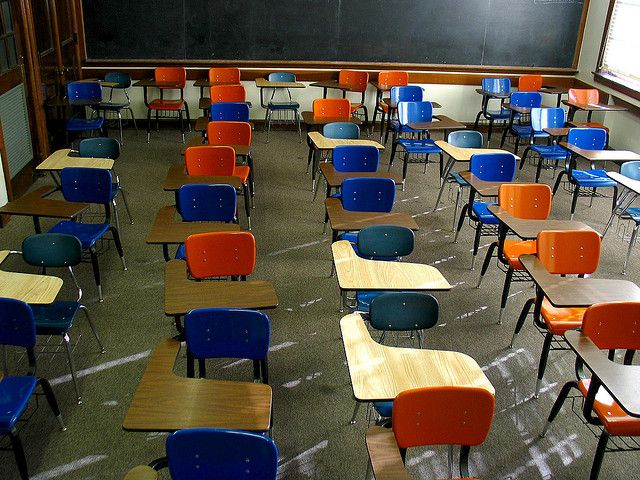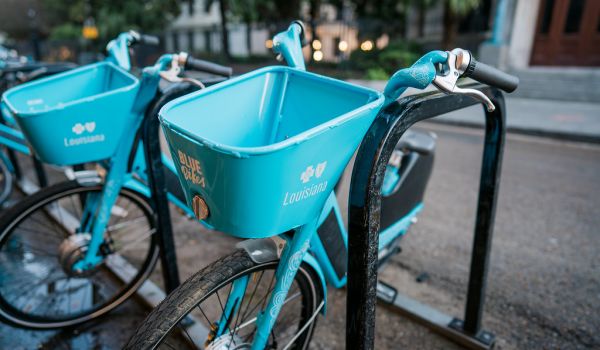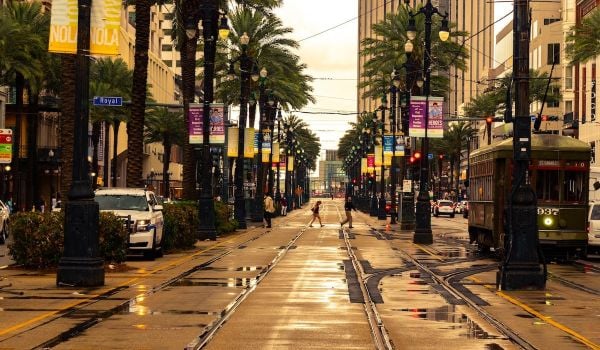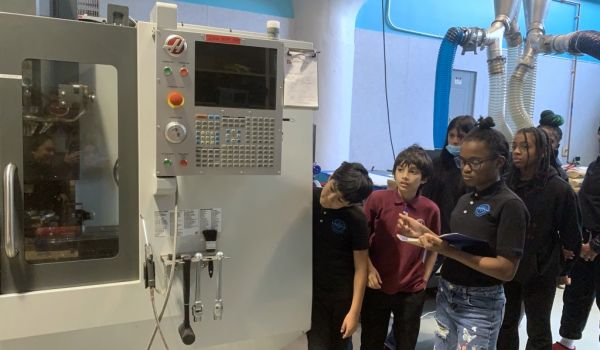This article is featured in Issue 28 of Next American City, on newsstands September 1. To subscribe and receive full access to all content, click here.
WHO RULES THE SCHOOLS?
by Ariella Cohen
After the forced exodus following Hurricane Katrina, New Orleans native Laura Irvin never thought she would leave her hometown again.
But this past summer, five years after that life-changing evacuation, the mother of two picked up and left again. She didn’t leave for a safer neighborhood or better employment options. The Lower Ninth Ward native says she liked the grassy subdivision in eastern New Orleans that she moved back to, and that her 9-to-5 gig at a corporate call center in the central business district fit her needs just fine. The push came from that other classic urban problem — the schools.
Last year the single mother was one of thousands of New Orleans parents who enrolled a child in one of the 59 independently operated, state-funded charter schools that have sprung up since Katrina dealt its watery death blow to the city’s long-troubled public school system. The $1 billion-plus charter movement is transforming a system once known for turning out illiterate graduates into a model for other cities grappling with how to build higher-achieving urban schools. For Irvin, however, the experiment, arguably the largest-scale intervention in education since desegregation, failed. Why? Because the culture of the school — led by young, white, highly educated reformers — felt isolating and unwelcoming to her. The complaint of alienation within a system she once felt a part of represents a growing challenge to the future of the city’s charter school movement, and more broadly, to future efforts to effect change in the city.
“I get vibes,” she says, “and I got the vibe that my child and I are not welcome in that school.”
Irvin’s son Edward is small for his five years and speaks in a thin, unsure voice that accents his slight frame. Even before he started kindergarten last fall, doctors diagnosed him with attention deficit disorder and a speech delay. Irvin remembers when the enthusiastic founding administrators of Pride College Prep came to her house to recruit her son for the school’s first kindergarten class. The team told her, she says, that they could manage his special needs, and that their holistic approach and regular yoga classes would help calm her hyperactive son.
But even with lines of communication intact, Edward’s first year at Pride was not easy for him or his mother. The kindergartner moved among three different teachers, two of whom were new to the classroom. Doctors decided that the pills he was taking for hyperactivity were damaging his liver and prescribed antidepressants for bipolar disorder. Irvin sparred, via email, with the school’s founder and director, Michael Richard, over everything from lunchtime supervision to discipline procedures to the language he used when he addressed her questions. In one email exchange over a schoolyard dustup she felt teachers should have told her about, she warned Richard that if things didn’t change he could expect her to “unleash” the tougher side of her personality. Richard’s response, reminding her that “you get more bees with honey than with vinegar,” and that the school was working “very hard to accommodate Edward’s needs,” only served to cement her irritation. By the end of the year Irvin felt increasingly alienated by the school’s teachers and by Richard, a well-educated and well-intentioned Teach for America alum recruited by New Schools for New Orleans, a nonprofit that offers funding and support to new public schools.
“The older teachers who used to be here,” Irvin recalls, “didn’t just impart the knowledge and teach — they used that mothering way. They knew how to snap their fingers and get the children to listen. They helped the parents raise the children.
“When my older son was in school, I was a room mother,” she adds. “Now if I go to my son’s teacher and ask a question, I get met with attitudes.”
AFTER DISASTER, RADICAL CHANGE
Before Katrina, New Orleans laid claim to the highest percentage of locally born residents of any major American city. The storm changed that, with the nativity rate dropping from 77 percent in 2000 to 73 percent in 2007. Until the 2010 Census is released, there is no way to know exactly how many natives still haven’t returned to the city, but one has to go only as far as the teachers’ lounge of the nearest charter school to sense how far the city’s demographics have shifted.
For decades before Hurricane Katrina, public schools in New Orleans were the province of African-Americans. A workforce that was roughly 73 percent black and 25 percent white taught a 93.5 percent black student body, according to an analysis of state education data compiled by Lance Hill, the executive director of the Southern Institute for Education and Research at Tulane University. Black politicians held a majority on the Orleans Parish School Board. A powerful, mostly black teachers’ union carried political clout, helping tens of thousands of black New Orleanians obtain the steady paycheck needed to ascend the economic ladder and buy homes in the suburb-like, postwar neighborhoods that would eventually become the geographic stronghold of the city’s dominant political class.
While the racial and socioeconomic composition of students has stayed the same following Katrina, the demographics of their instructors have changed. More than half of all teachers in the charter schools run by the state’s Recovery School District, which took over most of the city’s public schools after Katrina, were new to the classroom last year, with 32 percent of teachers in their first year of teaching and another 21 percent in their second or third, according to the Louisiana Department of Education. A large portion of the first- and second-year teachers — 485 in total — came to the city through Teach for America (TFA), a highly competitive national program that recruits recent college graduates, many from the country’s most prestigious universities, to commit to two years of work in low-performing schools around the country. Another 60 new teachers arrived in classrooms through teachNOLA, a locally based recruitment program supported by the Recovery School District and New Schools for New Orleans.
The increase in nationally recruited teachers — before the storm TFA placed only about 60 fellows a year in New Orleans — has meant fewer black teachers in schools. Program leaders say they are unable to recruit enough qualified teachers of color. TFA, for instance, weighs in with about 14 percent nonwhite teachers, according to Kira Orange-Jones, the director of the organization’s New Orleans chapter. “The goal for the region is 30 percent people of color,” Jones says. “We are searching for black teachers who meet qualifications and want to be here.”
By the 2009-2010 school year, the percentage of black teachers had dropped by nearly a quarter from pre-storm numbers to 52 percent, according to Hill’s analysis. By comparison, the share of white teachers increased from 13 percent to 38 percent, with more Asian and Latino professionals also moving into the system. “It’s a younger, whiter and more transient workforce than before the storm,” says United Teachers of New Orleans vice president Jim Randels. “We are seeing more and more people who are here for a few years as a stop on a career arc.”
How this change happened can be attributed to a confluence of trends in national public policy and philanthropy, and of course to a disaster that made incremental change impossible. Following Katrina, the state took over the public school system, effectively firing all of its 7,500 teachers and staff, so in addition to locating inhabitable classrooms, the state had to hire the people to staff them. Perhaps most critically, the storm literally displaced the existing political order, creating the opening for change.
“After the storm there was a vast realignment of political forces in the city,” Louisiana Federation of Teachers spokesman Les Landon says. “In the old days you could reliably predict which political organizations controlled the city. I do not know how much influence they have anymore.”
NO LONGER NEW VS. OLD
Five years after Katrina there is no consensus on whether the dissolution of the old way was a good thing for the city. “Everyone will agree the old school system was failing. Whether the change is real reform is unclear,” says Ronald Nabonne, a prominent black lawyer and political consultant. Nabonne points out that the charter school movement, whether positive or negative, has changed, as he puts it, “the complexion” of decision-makers. “The schools are being run by a white superintendent in Baton Rouge,” he says. “We have the first white mayor, the first white DA in decades.”
Right now it is impossible to gauge how many parents feel like Laura Irvin. Parents wanting to report problems with a school often get lost in complex layers of bureaucracy, and there is no system-wide, publicly accessible database of complaints. Adding to the murkiness is a high rate of mobility among families, many of whom transfer students between schools without so much as an exit interview that would explain whether the move is due to a change in address, a disagreement with a principal or a sense, like Irvin’s, that a child is not wanted in the classroom. That said, interviews with dozens of parents indicate that while some share Irvin’s concerns, most believe that the schools today are better than they were before the storm.“These teachers work hard for our children,” says Kowana Lyons, the mother of an eighth-grader at a New Orleans charter. “I can call my daughter’s teacher at 9 at night with a question about homework and she will pick up. That didn’t happen in her school before the storm.” Last year a poll done by a Tulane University-based think tank, the Cowen Institute for Public Education Initiatives, found that a majority of public school parents and childless voters in the city agree that the influx of new teachers is improving education. And though experts on all sides of the school-reform debate say it is too soon to assess the success of the New Orleans reform, signs points to progress. For instance, a lower proportion of schools was considered “academically unacceptable” by officials in 2009 vs. in 2005, an indicator that relatively fewer schools are failing now than were before Hurricane Katrina. Yet no matter how much academic progress the system makes, even the staunchest proponents of charter schools agree with critics who say that unless school leaders do a better job of integrating into the communities they serve, the new system will not succeed.
“We need to take a step back from the tensions that we see building and ask how to build community support,” says Carolyn Roemer Shirley, executive director of the Louisiana Charter School Association. “Because if we don’t, we are setting ourselves up for the kind of conflict that is very difficult to overcome.”
Likewise the city needs to move past the zero-sum game of new vs. old teachers. For new educators, the first years after moving to New Orleans were a time of late nights and exhilaratingly exhausting days. “The city was coming back. We were a part of it and it was inspiring,” says John Alford, a Harvard Business School graduate who grew up in public housing in Brooklyn and moved to New Orleans to start a school in 2006. For many of Alford’s pre-storm counterparts, however, this period was a nightmare.
“People had lost their homes and communities. Then they found out they had lost their jobs too and would have to compete with these kids from out of town to get them back,” recalls Wheeler Moorman, a fourth-grade teacher at a charter school in the Lower Ninth Ward.
What this amounted to was a profound disruption to the city’s social fabric, says Nabonne. “Thousands of taxpaying, home-owning teachers were displaced because of what happened after the storm,” he says. “A majority of them were black. Lawyers and doctors lost their clients. Politicians lost supporters. There is a collateral damage to losing all that.”
Kwame Floyd, who moved to New Orleans from his native New Jersey three years ago, may represent the future of compromise within the charter school movement. Both a Teach for America alum and black, the 26-year-old helped open a new charter, Lagniappe Academies, in the Treme neighborhood this fall. The school has tried to mediate that insider-outsider tension by reserving two seats on the board for area residents, with one seat going to a parent and the other to a community representative. While the school has no formal policy about hiring locally, he says that a quarter of its tiny starter staff consists of system veterans. (Another quarter of the staff, including Floyd, comes out of TFA.)
“My job is to keep families involved as a part of the school as much as possible,” the educator says, looking intently through a pair of small wire-rimmed glasses. In his view, the next five years of school reform should be about bringing local community back into the decision-making process. “As the charter movement grows,” he says, “we are seeing a bigger push for community-centered schools, and I think that will continue to grow.”And with those community-empowered schools comes even more demand for teachers who reflect the students and families they are teaching, says teachNOLA manager Ashley Angelico. She says the population of black New Orleanians will return, but likely not in the same numbers as before the storm. It is up to recruiters, she says, to make sure that educators do not become thought of as an outsourced commodity. She says her organization has put an “intense focus” on recruiting native African-American teachers from local universities and historic black colleges, and because of it, this year’s cohort includes significantly more New Orleanians of color than in previous years. “I do think it’s incredibly important to reflect the communities we work in,” she says. “Whether that will happen, I don’t know. I do not have a crystal ball.”
John Alford may not stay in New Orleans forever. Last year the native New Yorker resigned from the school he founded after a financial manger he hired embezzled more than half a million dollars. The resignation was a blow to parents at the school, as many saw Alford as a role model for their children: a young black man from the projects who ended up with a degree from Harvard and a job running a school. Since stepping down, he has been consulting for charter schools in New Jersey from New Orleans and looking for work that will allow him to stay in his adopted home. “As much as I want to stay, there is a good chance I will ultimately have to relocate,” says the former principal. If he leaves, Alford’s story will reinforce the fears of people like Nabonne, who worry that the education field’s influx of well-intentioned outsiders is a temporary phenomenon that will cost the city a stable black professional class. But while the business-student-turned-educator says he understands those fears, he says they are misplaced.
“Who was teaching in the schools before Katrina was based on politics, not results,” he says. “In the end that hurt everyone. In the long run what we are doing is helping kids get the education they are entitled to, and in time, this will build the black middle class.”
Ariella Cohen is Next City’s editor-in-chief.
Follow Ariella .(JavaScript must be enabled to view this email address)















